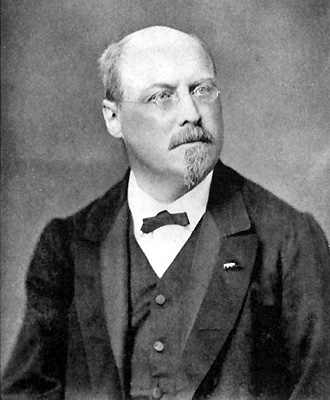In Raff and ready program, Kammerwerke offers colorful works for double winds

The Sinfonietta by Joachim Raff was performed by Kammerwerke Sunday in Newton.
As chamber ensembles go, the wind quintet ranks right behind the string quartet in terms of the number of performing groups on the concert circuit, and the quantity and quality of works that have been composed for it.
But a double wind quintet? What is that?
A select audience braved a late-spring heat wave Sunday afternoon to find out, as the Kammerwerke Double Wind Quintet, led by its music director Alan Pearlmutter, came to Newton‘s Evangelical Baptist Church with a colorful program of original and arranged works by Shostakovich, Raff, and Brahms.
If there was something oddly familiar about this exotic chamber ensemble—two each of flutes, oboes, clarinets, bassoons, and horns—it was because orchestral works of the late Classical and early Romantic periods commonly called for “double winds.”
It was as if the woodwind section of Beethoven’s Seventh Symphony had been plucked out from amid the violins, brass, and drums and set down to play music composed for it and it alone.
Instead of the five-way conversation of a wind quintet, this larger group is capable of a symphonic variety of color mixing, doublings, duets, and other effects. Curiously, however, it was the one work on this program originally composed for double quintet, Joachim Raff’s Sinfonietta, Op. 188, that sounded least effective, while the arrangements of a Shostakovich operetta and a Brahms serenade often seemed right at home in their new woodwind attire.
Of course, there was a quality factor at work here. Raff, a younger contemporary of Mendelssohn and Schumann, dipped from the same wells of fantasy and lyricism as they, and composed finely-worked, distinctive Romantic music that was hugely admired in his day and quite enjoyable to hear now. A half-hour with Raff’s four-movement “little symphony” for winds was 30 minutes well spent.
However, to be bookended by the fierce vitality of Shostakovich on one side and the inexhaustible imagination of Brahms on the other, as Raff’s piece was on Sunday, would be a tough assignment for almost any composer.
Composing under a Soviet regime that constantly proclaimed the nobility of the common man, Dmitri Shostakovich loved the real music of common people—the folk songs, jazz and dance tunes—for its cheerful subversiveness. Having worked his way through music school as a pianist in a cinema showing Charlie Chaplin films, he dusted off his musical-comedy skills decades later in Moscow Cheryomushki, Op. 105, a satirical operetta poking fun at grandiose Soviet public-housing schemes, with their inflated idealism and official corruption.
A suite from the operetta, originally scored for a pit band including strings and percussion, opened bracingly in Trevor Cramer’s wind arrangement with the calliope-like sound of a waltz tune led by Wendy Vignaux’s piccolo at its most piercing.
A mournful folk song à la Tchaikovsky and a mellower waltz rounded out the episodic, unabashedly “pop” Overture. Standouts among the arias and vignettes that followed were the jaunty, humorous song “Now It All Means Nothing,” a sizzling Polka (again featuring the piccolo), and the delirious traffic piece “A Spin Around Moscow,” to a cockeyed can-can beat.
Pearlmutter’s emphatic direction did not always bring cohesive results from his players, but at times the ensemble showed itself capable of true Shostakovichian razzle-dazzle, especially (it seemed) every time Vignaux set down her standard flute and reached for the piccolo.
The performance of Raff’s Sinfonietta could have used a bit of that sparkle in its allegro themes, to contrast with the first movement’s shapely chorale-style melodies. But the group marshaled the scherzo’s galloping rhythm effectively, brought out the play of thick and thin sound textures, and conveyed Raff’s distinctive sense of humor, somewhat Mendelssohn-like but more robust.
The Schumann-like warmth of the Larghetto came through, although the horns and bassoons could be overbearing at times. In the Vivace finale, Raff rivaled Dvořák for tunefulness and energy, and the players artfully managed the transitions from choppy to smooth and back again.
Before girding his loins to take on Beethoven in his First Symphony, Johannes Brahms composed a number of intriguing non-symphonies for orchestra, including the two relaxed yet wonderfully inventive Serenades. In Tony Turrill’s wind arrangement, the Serenade No. 2, Op. 16, took on a piquant new charm, and the Kammerwerke players responded with some of their most characterful playing of the afternoon.
Even in this easygoing piece, Brahms indulged his love of complications rhythmic and harmonic, especially in the opening Allegro moderato, which eventually got the players in a bit of a tangle. But the ensuing Scherzo featured lively interplay and an exciting windup.
The brooding drama of the Adagio ma non troppo became a struggle to stay in tune through Brahms’s ceaseless modulations, but the ensemble emerged into the sunlight of the swinging Quasi menuetto with a gleaming sound and some nice variations of texture.
Everybody took a virtuoso turn with the rondo finale’s fast triplets, including the horns. The movement kept its momentum through the well-characterized episodes, and once again piccolo power put it over the top.
Posted in Performances